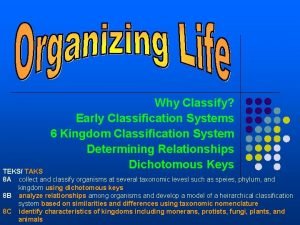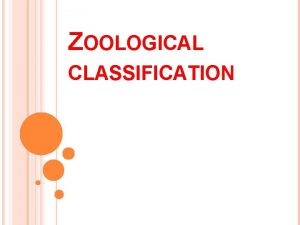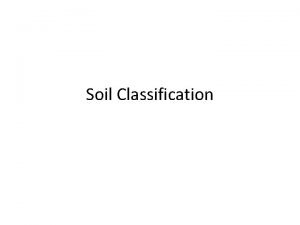Systems of classification Why classification is necessary The





























- Slides: 29

• Systems of classification

Why classification is necessary? • The biological world is enormously diverse. There are many varieties of living organisms so for properly studying them an approach is needed that enables us to get an idea of a group of organisms by studying a particular type. This calls for a systematic arrangement of organisms on the basis of their similarities and dissimilarities. Systematic arrangement of organisms on the basis of their relatedness is known as taxonomy.

How classification helps • The aim of classification is to identify and arrange organisms in such a manner that they fall into natural groups. They are classified on the basis of their most obvious characters. Those with similar characters are placed in the same group.

Binomial Nomenclature- • Linnaeus is the father of Taxonomy. Carolus Linnaeus is a Swedish botanist who is considered to be the father of taxonomy. He formulated a method of naming organisms called the binomial system of nomenclature. In this system each type of organisms has two Latin names- one for its genus and the other for its species. Thus all frogs have the genus name Rana and the Indian bullfrog has the species name tigrina. So the bullfrog is called Rana tigrina. Linnaeus also introduced a sequence of group of organisms or a way of classifying them.

• All organisms were divided into kingdoms. The kingdoms were divided into phyla, phyla into classes and classes into orders. Then came family followed by genus and species . Individuals of species bear closest resemblance to each other. The species within a genus have many common features. The genera of one family is more closely linked than those of another family.

Linnaeus(1758) recognised two primary kingdoms on the basis of some structural and functional characters like locomotion, response to external stimuli, mode of nutrition, conductile and contractile system and cell wall. • Organisms that freely moved from one place to another , well responded to external stimuli, ate holophaged food i. e. feed on other organisms or solid organic matters, possessed conductile (concerned with conduction of impulses) and contractile system (which expels excess liquid) in their body and lacked cell wall were considered to be animals and put under the kingdom Animalia. • On the other hand, organisms that did not freely move from one place to another , did not respond to external stimuli, did not eat food, lacked conductile and contractile system in their body, possessed cell wall were considered to be plants and put under the kingdom Plantae.

Advantage of this classification • To begin with, Linnaeaus divided all organisms into two kingdoms-plants (Plantae) and animals (Animalia). Plants and animals seemed so obviously different that this appeared to be a very logical way of classifying organisms. The main criteria for classification used by him included cell wall, locomotion, mode of nutrition, response to external stimuli and contractile vacuole.

Disadvantages • However with time, biologists started finding it more and more difficult o follow this system because some microorganisms showed characteristics of both plants and animals and could not be placed clearly in either kingdom. This kingdom system of classification does not distinguish between unicellular and multicellular organisms, eukaryotes and prokaryotes and photosynthetic(green algae) and nonphotosynthetic(fungi) organisms.

• There are few organisms like Chlamydomonas, Euglena and the slime molds that share the characteristics of both animals and plants. Since there are certain organisms that donot fall naturally into either plant and animal kingdom, it was proposed that a new kingdom has to be established to accommodate such organisms

R. H. Whittakerin 1969 proposed five kingdom classification. • He divided organisms into kingdom Monera, Protista, Fungi, Plantae and Animalia on the basis of the following criteria: • Cell structure, either prokaryotic or eukaryotic, • Thallus organisation, body differentiated or not, • Mode of nutrition, autotrophic or heterotrophic, • Reproduction, • Phylogenetic or evolutionary relationship.

Characteristics of the five kingdoms: • Monera-This group includes archaebacteria, bacteria and cyanobacteria. Cell type is prokaryotic, cell wall is non-cellulosic i. e. polysaccharides and amino acids are present, nuclear membrane is absent, body organisation is cellular, mode of nutrition is autotrophic(chemosynthetic& photosynthetic) and heterotrophic (saprophytic or parasitic).

Protista • This group includes phytoplanktonic algae, protozoa and slime molds. Cell type is eukaryotic, cell wall is present in some organisms, nuclear membrane is present, body organisation is cellular, mode of nutrition is autotrophic(photosynthetic) and heterotrophic

Fungi • Cell type is eukaryotic, cell wall is present but does not contain cellulose, nuclear membrane is present, body organisation is multicellular or loose tissue type, mode of nutrition is heterotrophic that is saprophytic or parasitic.

Plantae • This group includes macroalgae and plants. Cell type is eukaryotic, cell wall is present and contains cellulose, nuclear membrane is present, body organisation consists of tissues and organs, mode of nutrition is autotrophic which is photosynthetic.

Animalia • This includes invertebrate and vertebrate animals. Cell type is eukaryotic, cell wall is absent, nuclear membrane is present, body organisation contains tissue, organ or organ system, mode of nutrition is heterotrophic that can be holozoic or other types.

Merits • 1. Placement of prokaryotes separately in the kingdom Monera is well appreciable as the group plantae includes macroalgae and plants. Prokaryotes differ from all other organisms (eukaryotes) in their cellular, physiological and reproductive organisation. • 2. Many intermediate and transitional forms occur in unicellular eukaryotes, which have been included in both plants and animals. Placement of these unicellular eukaryotes in the kingdom Protista has removed this anomaly

• 3. Fungi have their own unique physiological, biochemical and structural characteristics, they are never related to plants. They are placed in the form of a separate kingdom. • 4. In this system the animal and plant kingdom appear more homogeneous than they were in two kingdom system.

Demerits • 1. It lacks distinction between archaebacteria and eubacteria. • 2. The kingdom Protista is too diverse to be taxonomically useful. • 3. The boundary lines between the kingdoms Monera, Protista. Fungi and Plantae are illdefined.

CARL WOESE’s Concept • Carl Woese and his colleagues performed molecular level genetic analysis of 16 S (prokaryotic) or 18 S (eukaryotic) ribosomal RNA(r. RNA) said to represent the analyses of conserved gene products permitting a direct assessment of genetic and thus, evolutionary relatedness of organisms. Ribosomal RNA (r. RNA) is considered to act as a good genetic indicator of evolution of one organism from the other.


Carl Woese of the University of Illinois and other molecular geneticists working primarily with bacteria have proposed that the prokaryotes themselves should be split into two groups. This split results in three kingdoms of organisms: the Eucaryota, the Archaeobacteria of Woese and the rest of the Procaryota • . The archaeobacteria are distinguished from the other prokaryotes by the sequences of bases in the ribosomal RNA, the chemical composition of the lipids and the cell wall structure. They constitute group of prokaryotes that are found in specialised and extreme habitats- the hot acidic niches of thermoacidophilic bacteria, the nearly saturated salt solutions of the extreme halophilic bacteria and the highly anaerobic environment required for the growth of the methaneproducing bacteria.

• According to Carl Woese, there are six kingdoms, kingdom-Archaebacteria, Kingdom-Eubacteria, kingdom-Protista, kingdom-Fungi, kingdom. Plantae and kingdom - Animalia. He separated the archaebacteria from the eubacteria on the basis of some major differences such as the absence of peptidoglycan in the cell walls of the former and the occurrence of branched chain lipids, a monolayer instead of a phospholipid bilayer, in the membrane

• Based on the sequence of 16 S ribosomal RNA genes, Woese found that the six kingdoms naturally cluster into three main categories. He called these categories as domains of life. These domains are Bacteria, Archae and Eukarya.

Difference between prokaryotic and eukaryotic microorganisms: • 1. Prokaryotic cell structure is present in bacteria but absent in eukaryotes. • 2. DNA in covalently closed and circular form is present in bacteria but absent in eukaryotes • 3. Histone proteins are absent in bacteria but present in eukaryotes. • 4. Membrane enclosed nucleus is absent in bacteria but present in eukaryotes. • 5. In the cellwall of bacteria, muramic acid is present but it is absent in the cellwall of eukaryotes

Difference between prokaryotic and eukaryotic microorganisms: • 6. Bacteria is sensitive to antibiotics chloramphenicol, streptomycin and kanamycin. But eukaryotic cells are insensitive to these antibiotics. • 7. Plasmid is present in bacteria but very rare in eukaryotes. • 8. In bacteria, the membrane lipids are ester linked and the same for eukaryotic cells. • 9. Nitrification, denitrification and nitrogen fixation are present in bacteria but absent in the eukaryotic cells. • 10. Chemolithotrophy is present in bacteria but absent in eukaryotes. • 11. Gas vacuoles are present in bacteria but absent in eukaryotes.




 Hey bye bye
Hey bye bye Domains and strands of ppst
Domains and strands of ppst यगत
यगत Why is sleep necessary
Why is sleep necessary Dot punch angle
Dot punch angle Single mode fiber joints
Single mode fiber joints Don't ask why why why
Don't ask why why why Why do classification systems change over time?
Why do classification systems change over time? Hát kết hợp bộ gõ cơ thể
Hát kết hợp bộ gõ cơ thể Slidetodoc
Slidetodoc Bổ thể
Bổ thể Tỉ lệ cơ thể trẻ em
Tỉ lệ cơ thể trẻ em Chó sói
Chó sói Tư thế worms-breton
Tư thế worms-breton Alleluia hat len nguoi oi
Alleluia hat len nguoi oi Kể tên các môn thể thao
Kể tên các môn thể thao Thế nào là hệ số cao nhất
Thế nào là hệ số cao nhất Các châu lục và đại dương trên thế giới
Các châu lục và đại dương trên thế giới Công của trọng lực
Công của trọng lực Trời xanh đây là của chúng ta thể thơ
Trời xanh đây là của chúng ta thể thơ Mật thư tọa độ 5x5
Mật thư tọa độ 5x5 Làm thế nào để 102-1=99
Làm thế nào để 102-1=99 Phản ứng thế ankan
Phản ứng thế ankan Các châu lục và đại dương trên thế giới
Các châu lục và đại dương trên thế giới Thể thơ truyền thống
Thể thơ truyền thống Quá trình desamine hóa có thể tạo ra
Quá trình desamine hóa có thể tạo ra Một số thể thơ truyền thống
Một số thể thơ truyền thống Cái miệng nó xinh thế chỉ nói điều hay thôi
Cái miệng nó xinh thế chỉ nói điều hay thôi Vẽ hình chiếu vuông góc của vật thể sau
Vẽ hình chiếu vuông góc của vật thể sau Biện pháp chống mỏi cơ
Biện pháp chống mỏi cơ





















































